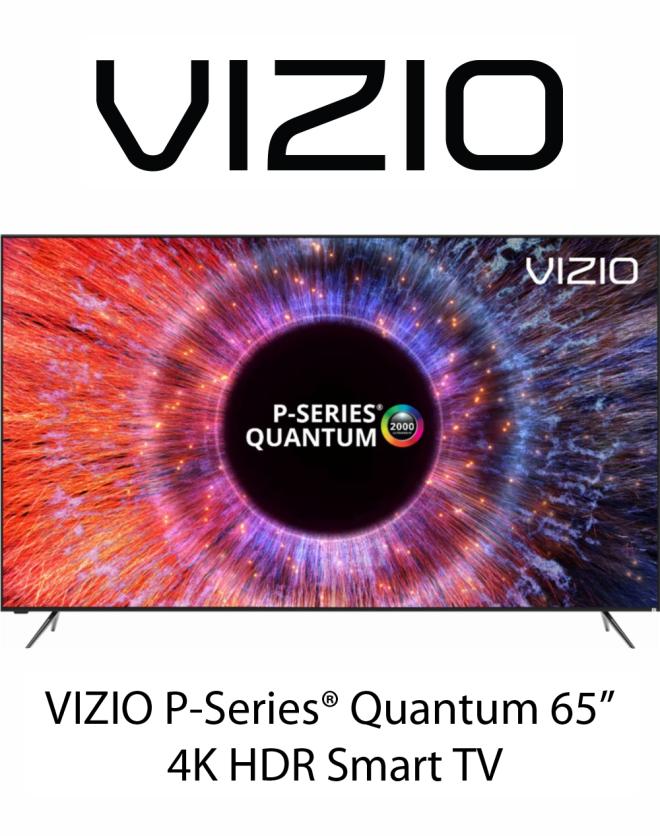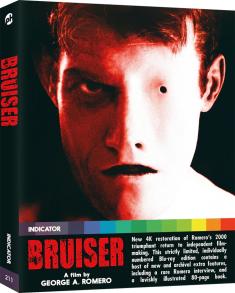VIZIO PQ65-F1 65" P-Series Quantum 4K HDR UHD TV
Overview -Overview – Designed to compete with LCD models that cost about $1,000 more, the VIZIO PQ65-F1 P-Series Quantum 4K Ultra HD TV features support for Dolby Vision and HDR10 with over 2,000 nits peak brightness, P3 wide color gamut coverage with quantum dots, Full Array Local Dimming with 192 zones, and SmartCast streaming capabilities. And though there is a bit more blooming during some content than I would have liked, the performance offered here is great for the price. In fact, this is easily one of the brightest 2018 4K HDR displays on the market. If you want a genuine premium 4K home theater experience for under $2,500, then the PQ65-F1 is Highly Recommended. Order HERE from Best Buy!
Intro
After already launching one of the best bang-for-your-buck 4K HDR TVs on the market with the standard P-Series, VIZIO is now stepping their game up even more with a true flagship display that not only holds its own against competing high-end LCD sets, but, in some cases, actually surpasses them.
As a brand new model for 2018, the VIZIO PQ65-F1 P-Series Quantum 4K HDR TV offers genuine top-of-the-line performance for a current MSRP of $2,100 -- reaching specs that many manufacturers charge at least $3,000 for.
But while some tradeoffs have been made here and there, there really isn't a comparable LCD or OLED out there for less than $2,500. And if previous sale prices are any indication, the P-Series Quantum could even get marked down to as low as $1,500 during the Black Friday deal season.
Specs & Design
The 2018 PQ65-F1 4K HDR Ultra HD TV is currently available in a lone 65-inch screen size option. The display uses a VA LCD LED panel with a 16:9 aspect ratio, an Ultra HD resolution of 3840x2160, and a 120Hz native refresh rate. In addition, the panel features full array local dimming with 192 zones. Likewise, Dolby Vision, HDR10, and HLG high dynamic range playback capabilities are included as well, along with DCI-P3 wide color gamut coverage with quantum dot technology.
Stepping things up a little from the standard P-Series, the display features a similar but slightly more premium industrial design with thin black borders around the entire screen instead of a typical, thicker bezel. The back panel has a black textured plastic construction, and the unit's profile measures about 2.5" at its thickest point. Silver metal left and right feet stands are included as well which, once again, offer a slightly more premium look compared to other VIZIO models thanks to a shiny finish.
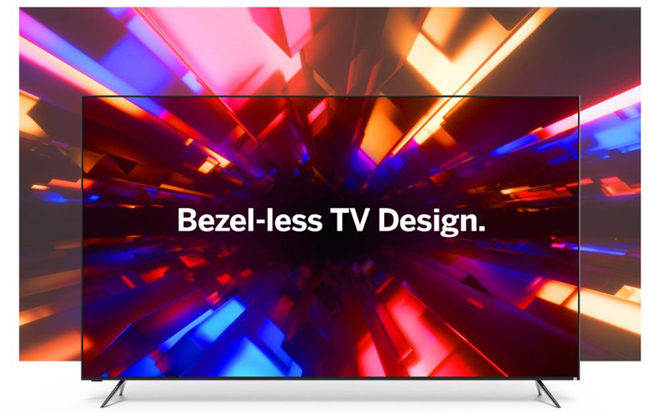
With the feet attached, the TV measures 56.96" x 35.11" x 11.81", and weighs 54.90 Lbs. Three HDMI 2.0 inputs (including one ARC), optical and analog audio outs, a cable/antenna input, and an Ethernet port are all located on the back toward the bottom right. In addition, a USB 2.0 port, Component/Composite inputs, and two more HDMI inputs are located on the right side of the panel. Meanwhile, the power connection is housed on the bottom left side.
Under the hood, a V8 Octa-Core Processor running the SmartCast platform powers the display, along with the company's VM50 Engine picture processor. 802.11ac Dual Band Wi-Fi connectivity is included as well. In addition, the package comes with a simple black click button remote. But while perfectly functional and a solid fit for the rest of the company’s lineup, the remote's relatively cheap look and feel is a little at odds with the P-Series Quantum's otherwise premium aesthetic and performance. Meanwhile, users can also opt to control the display via the SmartCast mobile app as well. Likewise, voice control for select commands can be conducted via a separate Amazon Alexa or Google Assistant device.
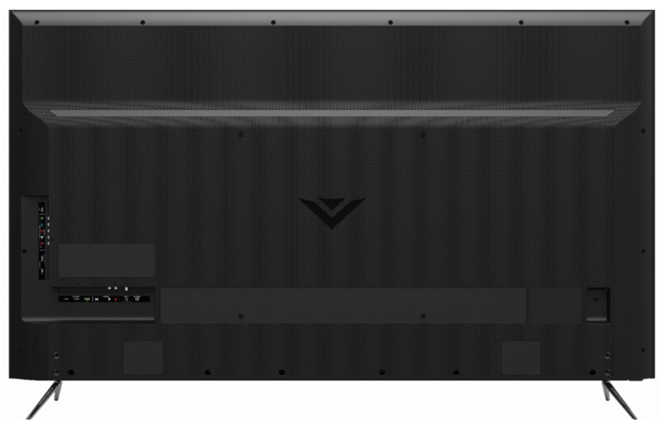
Finally, for those without a separate audio setup, the TV features integrated 10w x 2 speakers. Like most built-in audio solutions, the speakers get the job done for very casual viewing but most users will definitely want to pair this set with an external sound bar or full surround sound system.
Setup
After unpacking the box, setup is pretty simple and essentially identical to the standard P-Series. Once you've got the feet attached, all your external devices connected, and the display booted up, the TV will prompt users to select a language, choose home or store use, and configure a Wi-Fi connection.
After connecting to the internet, the display will download any applicable updates and then restart. Some more general configuration options (TV location, local channels) are then presented before asking users to accept VIZIO and Google's terms of service and privacy policies. Finally, customers are given the option to register an account with VIZIO and then… you’re all set to start watching!
During my evaluation, I primarily hooked up an Onkyo TX-NR555 receiver to the display's HDMI ARC (audio return channel) input, allowing the receiver to pass-through full bandwidth 4K Ultra HD Dolby Vision/HDR10 content to the screen and the display to transmit audio from its apps to the receiver.
With ARC and CEC (consumer electronics control) enabled in the menu, the display automatically recognized that a receiver was connected and used that corresponding label for the HDMI input. Thanks to CEC, I could also use the TV's remote to adjust the receiver volume. Likewise, the display was capable of successfully sending Dolby Atmos audio from VUDU and Amazon Prime Video to the receiver.
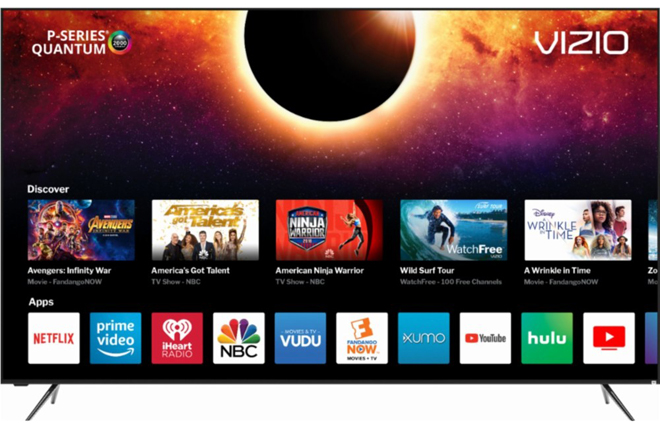
Thankfully, unlike the regular P-Series, I didn't run into any HDMI signal issues with my LG UP970 4K Blu-ray player or Roku 3, whether connected straight to the TV or via passthrough from my receiver. Unfortunately, however, I did encounter the same problem I had with that model when using the new Amazon Fire TV Stick 4K through the HDMI 1 input.
When Full UHD Color (the mode needed to provide HDR support for many external devices) was activated for that port, the screen would sometimes flash repeatedly, disrupting playback from the device -- whether connected directly to the display or via the receiver. Deactivating Full UHD Color would correct the issue, but at the cost of preventing Dolby Vision output and restricting the device to HDR10. Meanwhile, the other HDMI ports operated just fine with the Fire TV Stick 4K and Full UHD Color mode.
I'm not sure how widespread this problem is, but at least two Best Buy user reviews mention a similar signal issue with some devices. Assuming this is an isolated quirk, buyers should be able to swap out defective units for replacements if they encounter anything like this. Since I was able to use the Fire TV just fine with another port, the issue didn't actually negatively impact my experience, but it is something customers should know.
Finally, when it comes to picture calibration, the PQ65-F1 offers a comprehensive assortment of adjustments and modes. In general, the Calibrated Dark mode with all unnecessary enhancement options deactivated and Local Dimming set to Medium will provide the most accurate out-of-box SDR and HDR playback suitable for most users. Of course, if one desires to perform a full white balance and greyscale calibration, the TV offers more than enough control to fine tune things even more.
Local Dimming
Like most VIZIO displays, the PQ65-F1 features Full Array Local Dimming. This technology uses LED light sources positioned in multiple dimmable zones across the TV's panel, allowing the screen to brighten or darken in selected spots to coincide with the content being played. As a result, the display is able to achieve deeper black levels and more precise HDR highlights compared to edge-lit models or LCDs without any dimming.
The effectiveness of local dimming is based largely upon how many zones a manufacturer is able to implement in their panel (typically, the more the better) and the particular algorithm a company uses to tell those zones how to operate. The P-Series Quantum comes equipped with 192 zones. For comparisons sake, the standard 65-inch P-Series offers 100 zones and Samsung's flagship 65-inch Q9 comes with around 480 zones.
In practice, the local dimming is very solid but not quite as consistent as I was expecting. The tech allows the TV to achieve fairly deep and uniform black levels for an LCD. With that said, letterbox bars don't quite disappear into a dark room the way they do on an OLED panel or Samsung's Q9 QLED TV. Likewise, black levels become a bit higher when the TV is displaying HDR10 or Dolby Vision content, losing some of the inkiness achieved with SDR playback. And though the set features more zones than the standard P-Series, I did not notice any improvement in black level performance over that model. In fact, there are aspects of the Quantum's local dimming that are actually a little more problematic.
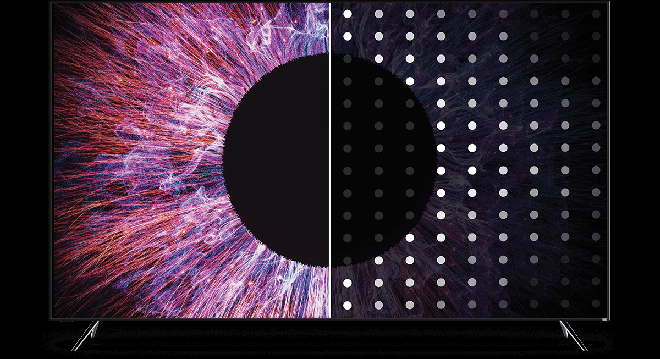
For general SDR and HDR content, VIZIO recommends keeping the local dimming setting on Medium. In my experience, this mode did indeed produce a better balance between peak brightness and blacks over other modes. Unfortunately, however, even on Medium, the display was sometimes prone to more blooming than the standard P-Series.
Blooming was most evident in HDR videos and was especially noticeable in movies and shows with more neutral or grey/blue palettes. On that note, Netflix's The Haunting of Hill House proved to be a particularly tricky title for this TV, resulting in some noticeable haloing around characters and objects like lamps and candles throughout several episodes. Chilling Adventures of Sabrina also gave the set's local dimming a workout, causing blooming and backlight fluctuations that were a little more noticeable than I would have liked. And though less of a bother, haloing was also very apparent around text and loading graphics when navigating through menus in apps like YouTube and Amazon Prime Video.
To be clear, most content still benefited nicely from the local dimming with no major blooming issues, resulting in very impressive contrast, with great blacks and some of the industry's leading brightness capabilities. But at times, it appears like the set's incredible nit performance comes with an occasional tradeoff, causing the incredibley bright zones to bleed a bit into other areas of the screen during some material. For comparisons sake, with more than double the amount of zones, the similarly bright Samsung Q9 is capable of less blooming and deeper blacks. Of course, that set costs more and is prone to its own notable local dimming quirks, particularly when it comes to crushing shadow detail.
In other words, no TV is perfect. At the end of the day, though not quite as seamless as I was hoping for, the benefits of the local dimming feature still far outweigh any occasional side effects.
4K HDR Performance
To demo the PQ65-F1's Dolby Vision and HDR10 picture performance I sampled a variety of 4K Ultra HD Blu-ray discs and streaming content from services like Netflix, Amazon Prime Video, and VUDU, including titles like Ant-Man and the Wasp, Fantastic Beasts and Where to Find Them, Game of Thrones, Love, Simon, Blade Runner, Ex Machina, La La Land, Sucker Punch, Jack Ryan, The Grand Tour, The Haunting of Hill House, Chilling Adventures of Sabrina, Altered Carbon, Lost in Space, and more.
Though VIZIO states that the TV is capable of a whopping 2,000 nits, I actually found that the display could offer peaks even higher than that -- with some test patterns getting as high as 2,400 nits in the Calibrated Dark mode! This easily cements the P-Series Quantum as one of, if not the, brightest 4K HDR TVs of 2018 (the Samsung Q9 can get brighter in bursts, but only in its dynamic mode). Meanwhile, the display also uses quantum dot tech to provide close to 100% DCI-P3 wide color gamut coverage.
And thankfully, those specs add up to some truly impressive real-world performance. In general, 4K HDR content looked incredible during my testing, producing sharp details, sumptuous colors, deep blacks, and striking contrast. Though not quite a night and day difference over the already impressive standard P-Series, the Quantum still offers an appreciable upgrade, producing a glossier image that stands toe-to-toe with flagship sets from other manufacturers.
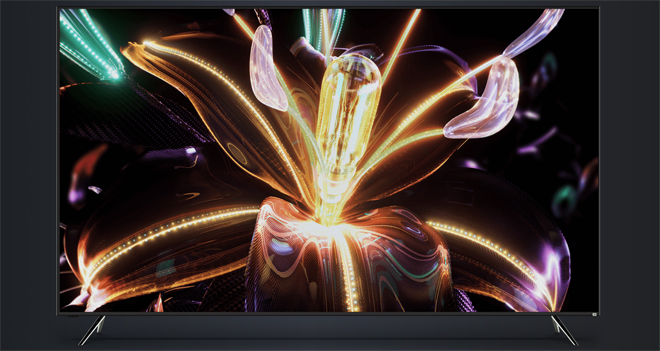
The dazzling colors and sparkling highlights of the quantum realm in Ant-Man and the Wasp provided an especially great demonstration of the TV's 4K Blu-ray performance. Likewise, Fantastic Beasts offered a great mixture or deep shadows and vivid imagery, allowing the TV to showcase both extremes with appropriately fantastic contrast. The specular highlights on the magic wand blasts during the film's climactic battle scene were particularly eye-catching, reaching peaks so high they made me squint.
Comparatively restrained titles, like Love, Simon, also looked quite lovely, with the P-Series Quantum maintaining a colorful yet still natural appearance, avoiding overly harsh skintones. And on the streaming front, shows like Jack Ryan, The Grand Tour, Altered Carbon, and Lost in Space, all came through with beautiful clarity. The Grand Tour and Altered Carbon make for especially great demo material, and the Quantum rendered every bold red supercar or neon-lit cityscape with deep color and precise highlights. Meanwhile, the odd blueish tinge I noticed in shadows on the standard P-Series during some scenes in Jack Ryan was nowhere to be found here on the Quantum.

With all that said, as I mentioned in the local dimming section, blooming was an occasional issue with some HDR material I watched, causing noticeable haloing around objects and characters at times. Again, some titles proved to be more prone to this than others and, overall, blooming issues were more the exception rather than the rule.
Offering comparable and, in some cases, even more impressive HDR specs than competing flagship LCD sets that cost about a thousand bucks more, the P-Series Quantum really is a strong performer. Even with some blooming issues here and there, the set's picture quality is often stunning.
1080p SDR Performance
Outside of 4K HDR content, I also sampled several SDR Blu-rays and streaming shows, including titles like Star Trek into Darkness, The Dark Knight Rises, Wonder Woman, Roger Waters The Wall, Shameless, The Good Place, American Horror Story, It's Always Sunny in Philadelphia, and more.
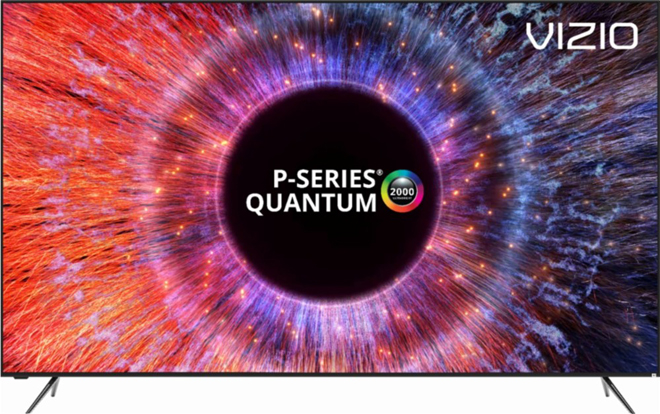
As a whole, HD material looked nearly flawless. As with the standard P-Series, black level performance was actually a bit deeper when displaying SDR content, and this resulted in a slightly inkier appearance with less visible black bars. Likewise, though still apparent with some content, the local dimming's blooming was less of an issue with SDR material.
The shadowy fight scenes in Dark Knight Rises came through with inky blacks and good detail, while all the lens flares in Star Trek into Darkness popped brightly from the screen, even without the added benefits of HDR. Even lower quality streaming material upscaled quiet well and, as a whole the set maintained even contrast, good Rec. 709 color accuracy, and great shadow delineation.
Uniformity, Viewing Angles, & Reflections
When it comes to screen uniformity, the PQ65-F1 is quite good, offering a slightly more uniform image than the standard P-Series I previously reviewed. Of course, that could have more to do with general panel variances that any actual difference between the models themselves. When viewing various full-screen grey and color patterns, some very faint vertical bands were sometimes visible along with other minor differences in brightness. Likewise, the very edges of each corner appeared darker than the rest of the screen, but less so than they did on the regular P-Series.
A very mild dirty screen effect was also visible during some content with bright backgrounds and lots of motion and panning (like hockey games), but again, these irregularities were less severe than the regular P-Series model I tested and were never much of a factor during real-world playback.
Meanwhile, thanks to the set's local dimming, backlight uniformity was great and free from any major clouding when displaying an all-black screen.
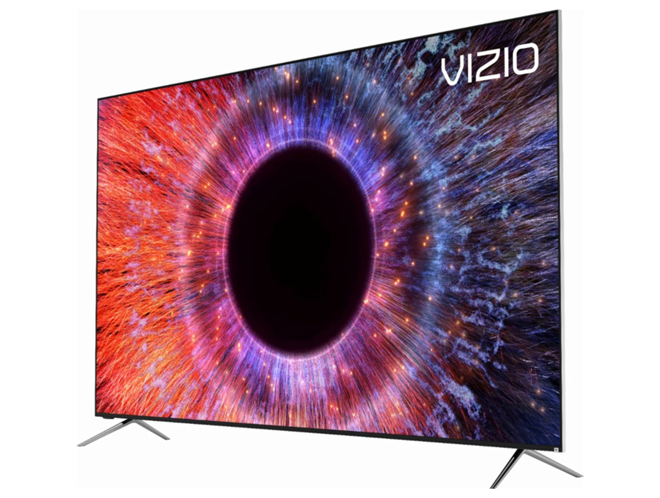
Unfortunately, like the standard P-Series, viewing angles were less than ideal. Colors and contrast would take a hit when viewing from a seat just off to the side, and blooming became even more noticeable from off-axis. I also noticed slight shifts in picture quality on the extreme left and right sections of the image even when sitting directly in front of the TV on some isolated titles – but this was less of a problem than it was on the regular P-Series. It should also be noted that the Quantum actually offers a special "Enhanced Viewing Angle" option that can be toggled in the menu to help improve off-axis viewing. In practice, I found that this feature offered a nearly imperceptible shift in contrast that didn't really provide any benefit.
Finally, the screen does a very nice job handling reflections, offering good viewing conditions even with a lot of light in the room. Reflections could be seen on the display in my living room with the curtains pulled back when darker images were on the TV or if an overhead light was turned on directly across from the display, but by and large, most users should be pleased with the performance here.
SmartCast & Voice Control
Powered by the SmartCast platform, VIZIO's smart TV interface continues to be bit of a mixed bag, offering similarly decent but occasionally glitchy performance as the standard P-Series. The system offers on-screen access to select apps like Netflix, Amazon Prime Video, Hulu, VUDU, YouTube, YouTubeTV, FandangoNOW, Crackle, NBC, XUMO, iHeart Radio, and VIZIO's new WatchFree service powered by PlutoTV. For the majority of additional apps, however, users will need to cast supported services to the display from a separate mobile device or PC.
In general, both options work pretty well… most of the time. Unfortunately, a few glitches and quirks cropped up during my testing. Most notably, the SmartCast app on my phone would occasionally stop recognizing the display and the cast icon would occasionally disappear as an option from supported videos on my laptop as well.
More problematic, however, were sporadic crashes that would occur in apps like Netflix or Amazon, causing the display to lock-up and eventually restart itself. This happened a few times with the standard P-Series I previously reviewed, but occurred a bit more here, particularly when watching HDR streaming content. I wouldn't say the issue was common, but it did happen more than I would have liked.
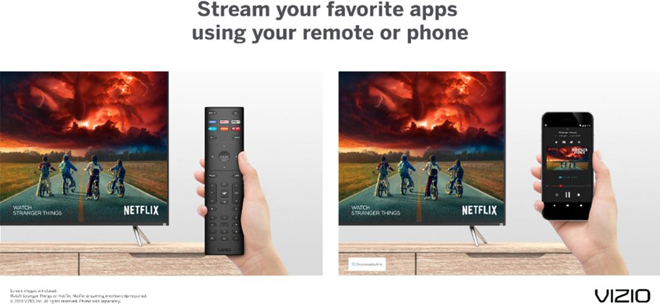
Thankfully, the majority of streaming playback was smooth and problem free, with support for 4K HDR10 and Dolby Vision (when available) from Netflix, Amazon Prime Video, VUDU, and YouTube. Meanwhile, FandangoNOW would play content in 4K but not HDR. On-screen navigation could be a bit sluggish, however, especially compared to some other smart TV platforms, but functionality was never seriously hindered.
Beyond streaming, VIZIO has also added a voice control feature to its SmartCast OS this year via a separate Amazon Alexa or Google Assistant device. With that in mind, VIZIO was kind enough to include an Echo Dot with my review unit (not included with retail models).
To pair the Echo Dot with the display, users will need to create a VIZIO account and download the Alexa app on a mobile device. After that, customers can download the SmartCast skill through the app and then follow the instructions to link the devices. Once this relatively simple setup is complete, voice control will be enabled for simple functions like powering the TV on/off, adjusting volume, play/pause, and switching inputs. With that said, more advanced commands -- like launching specific apps/programs or searching for streaming content -- are not supported through Alexa, though some of these functions can be done with Google Assistant.
In practice, Alexa voice control worked quite well, adding hands-free convenience to power and volume commands. There were sporadic instances when Alexa would seemingly get confused and not follow a command -- but overall I found this to be a worthwhile and reliable feature.
Final Thoughts
Pros
- Dolby Vision, HDR10, and HLG support with over 2,000 nits
- Wide Color Gamut capabilities with quantum dots
- Full-Array local dimming with 192 zones
- Voice control via separate Alexa or Google Assistant devices
- Competitive pricing for a flagship LCD
Cons
- Noticeable blooming in some content
- SmartCast platform prone to glitches
- Potential "Full UHD Color" HDMI signal issues
- Superior black levels on OLEDs and some LCDs
Holding its own against competing flagship LCD models that cost more, the VIZIO P-Series Quantum offers great performance, easily cementing itself as not only one of the year's best values, but also one of the year's best displays period.
With that said, the set's incredible brightness capabilities do result in more noticeable blooming and haloing in some content than I would have liked. Meanwhile, the SmartCast platform can be prone to glitches and crashes, some units might have HDMI signal issues, and viewing angles leave a bit to be desired.
All things considered, I was ultimately a bit torn about the final score here and came close to bumping this up half a star to a 4.5. In the end, the issues I ran into and the increasingly competitive pricing for some LG OLED models were just enough to keep this at a strong 4.
There are some local dimming LCDs on the market with less blooming, and there's an entry-level OLED set for about $500 more with better overall picture quality, but if you want industry-leading HDR brightness for under $2,500, then the PQ65-F1 P-Series Quantum 4K Ultra HD TV is the display to beat. At a current MSRP of $2,100, it's already a solid deal, but at past and hopefully future sale prices as low as $1,500, it's a no-brainer. Highly Recommended.
